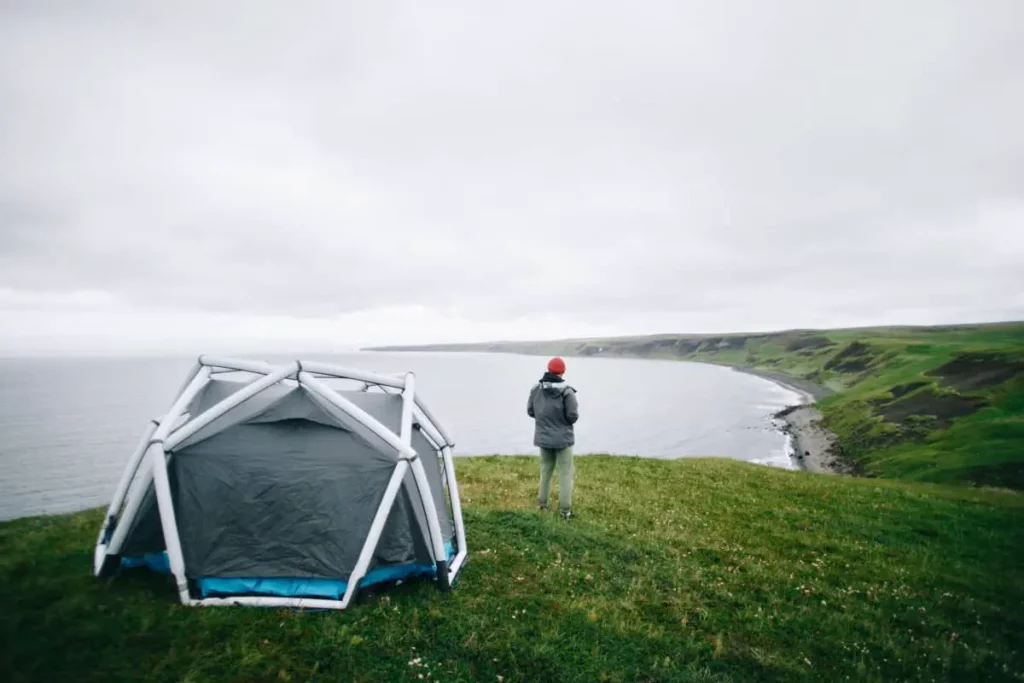This post contains affiliate links.
Inflatable tents, also known as air tents are a great alternative to traditional camping tents. They are roomy, easy to set up and take down, and come in many different sizes from single-person to party size.
Air tents use inflated beams instead of poles to act as the structure that holds up the tent. The beams are air pockets built into the tent material so there are no extra pieces to bring.
Using an inflatable tent may be the best way to make your camping experience easier and more enjoyable. Below you’ll find all the details, tips, and tricks you need to decide if an air tent is right for you.

Table of Contents
How Air Tents Work
We all know how traditional tents work – and how they can be a huge hassle. You have to struggle to thread the poles in their sleeves, make sure you have all of the right parts in the right places, and then actually pitch it.
Air tents remove some of that struggle by building all of the supports into the tent material itself. In other words, you don’t have to worry about keeping track of poles because they’re already part of the tent.
Rather than using traditional poles, however, the air tent uses columns of high-pressure air to support it. These air supports are spaced around the tent at regular intervals, and to set your tent up you just have to blow up the supports from the valve(s).
You do still have to stake your tent down and it’s even more important given its lightweight structure, but the inflatable nature of the tent means that setup time is slashed to just minutes.
Air tents can come in all shapes and sizes, from single-person to 6+ family tents. You can get tunnel tents that let you add on expansions as needed as well as dome tents in more traditional shapes.
- STURDY COIL BEAM: This inflatable camping mattress features a Sturdy coil beam construction for exceptional spine support and comfort....
- INDOOR AND OUTDOOR READY: This blow up tent air mattress combo has a Windproof and Waterproof construction and it is specially designed for...
- MADE TO LAST: SereneLife camping gear air mattress blow up tents are made of heavy-duty PVC and polyester for superior stability and have a...
Pros and Cons of Inflatable Tents
Inflatable tents sound pretty cool, right? Before you run out to buy one, however, you should consider all of the pros and cons that come with them. For more camping gear tips check out our post on What to Bring Camping in a Tent.
Pro: Weight
If you’re backpacking, you’re trying to make your pack as lightweight as possible. Many pole tents have made use of aluminum poles to try and shave ounces off, but air tents are even lighter due to their lack of poles.
If you have a long backpacking trip planned or even if you just want to lift a little less as you’re setting up at the campground, air tents are definitely one of the lightest options available.
If lightweight camping is your thing don’t miss our post on The Best Minimalist Camping Gear.
Pro: Ease of Setup
As I mentioned, ditching the poles gets rid of a lot of the hassle that comes with setting up traditional tents. Some air tents even have all of the support pillars interconnected so you only have to inflate them from a single valve.
Unlike large pole tents, you only need one person to set up an inflatable tent. This makes it easy for families and large groups to get set up fast, and cuts down on the number of arguments it takes to get there.
Con: Price
These things are awesome, but they aren’t cheap. Backpackers will tell you that anything designed to be lightweight will have a couple more dollars added to the price tag, but when you have something that’s both lightweight and a new technology it drives the price up even more.
It’s hard to say right now whether the price of air tents will come down to be more comparable to pole tents in the future, but as long as they remain a novelty you can expect to pay top dollar for them.
Con: Air Pump Required
The air columns that support the tent require a large volume of air to keep the tent upright, filling them up will require more than a few lung fulls. To fill your air tent you’re going to need a pump, either electric or manual depending on your access to electricity and determination.
This presents two potential issues: first, you may or may not have to purchase an air pump separate from the tent. Be sure to check whether the air tent you purchase comes with a pump or not, some do include a small electric pump while others utilize the bag as a pump sack.
The other potential issue is that for backpackers you have to carry and store the air pump. There are small battery powered pumps available to take with you into the wilderness and they can be charged using a USB connection to a power bank. Even the compact and lightweight hand pumps will take up precious space, so what you make up in ounces with an inflatable tent you may lose in pack space.
- ➤【QUICK INFLATION/DEFLATION】- Flextailgear portable air pump features 300L/min wind speed and 2 kPa air pressure, which ensures rapid...
- ➤【POWERFUL & RECHARGEABLE BATTERY】- With large 3600mAh lithium battery, our rechargeable air pump works up to 45 minutes after fully...
- ➤【MINI SIZE AND PORTABLE CARRY】- Weighs only 5.3 oz, this max pump is ultra-light and portable, you can put it in the backpack or...
How To Set Up an Air Tent
First things first – you need to lay out the tent and align the support beams as straight as you can get them on the ground. This will make sure that air is able to flow freely through the tent and not get hung up on any snags or bends in the material. In this regard it’s just like your water hose.
Once you have the tent laid out properly, locate the valves on the support beams. Keep in mind that the valve may be under a pocket of tent material or even in a zippered flap. Depending on the style of tent you have there may be multiple valves located on each pillar or there may be a single centralized valve that blows up everything at once.
The valve will have a screw cap on top of it, and underneath you will see the valve opening itself. Make sure that the pin is facing upright, and you’re good to start pumping. You can work from front to back or back to front, but move down the tent inflating the pillars to the proper PSI using the air pump.
Your pump should have a pressure gauge on it, and the manual for the air tent will tell you what pressure each pillar should be inflated to. Once all of the pillars are inflated your tent will look much more like it’s finished form, and there may just be an overhang or other flap to pull out to finish the job.
Now that your tent is inflated, you need to stake it down to make sure it doesn’t go anywhere. Your air tent should come with guy lines and pegs, and your user manual should tell you exactly how to stake it so that your tent stays steady. This is just like staking down a pole tent at its corners and with guy lines on the sides.
- Good helper of outdoor adjust the rope,Help to lock the cord and prevent it skids away
- This is a new design products, more convenient to use than other products,and more easily
- Size: 1.7 x 0.6 x 0.08inches . Weight: 0.08 ounces; Diameter of the Hole: 0.2 inch
Do Inflatable Tents Come With Pumps?
Some brands like Heimplanet sell their tents with their own air pump, and others don’t. Overall this could actually be good or bad – while you don’t want to shell out a bunch of money for a tent just to have to turn around and buy a pump, it would let you get the kind of pump that best suits your needs.
Want the one that’s going to blow up your pillars in 3 seconds flat? You can get it. Want the one that’s going to be the lightest and most compact to put in your pack? You can get that one instead. Just make sure you know ahead of time whether the tent you choose comes with a pump so you don’t have a bad situation on your hands later.
Are Air Tents Reliable?
The last thing you want to do is wake up to a deflated tent because you got a puncture or leak. Fortunately that’s not likely to happen with air tents. The support beams are made of a plastic called Thermoplastic Polyurethane, which offers both abrasion resistance and a little elasticity so it gives before it tears.
One thing that will damage your tent, however, is overinflating the support pillars. This can cause them unnecessary stress and make them more likely to pop. As long as you follow all of the manufacturer’s recommendations, your tent is more likely to be damaged by improper storage than while you’re camping (unless a bear tries to get in your tent, but I haven’t found one yet that’s bear-rated).
To store your tent, make sure you fold it however the manufacturer recommends and that you only keep it in the travel bag it comes with. As long as you take the right precautions with your inflatable tent they can be as reliable if not more so than a regular pole tent.
Can Inflatable Tents Handle The Wind?
If you’re like I was, you probably have a mental image of an inflatable tent floating off like the house from The Wizard of Oz if the wind gets up to anything more than a light breeze. After doing some more research, however, I can assure you that air tents are well-equipped to handle blustery situations – though no tent is likely to survive a tornado.
Air tents have two advantages over traditional pole tents: they are less likely to break and they are more likely to stay in place. How can that be, you ask? Pole tents are supported by, well, poles, and those poles can only bend so far before they snap like twigs at their weak points.
A deflated pillar is manageable – you might be able to smack some duct tape over the blowout and fill it back up. A broken pole is harder to fix. When inflatable tents encounter high winds, they are much more flexible and able to give more due to their structure, as long as they are filled to the proper PSI.
As for staying on the ground, many pole tents are only staked at the corners, and others only have two to four guy lines. Air tents on the other hand usually have at least 10 guy lines. No matter what type of tent you have, it’s going to act like a giant sail when the winds come blowing, and the more points of contact you have with the ground the better off you’ll be.
Check out our post on Is it Safe To Camp In A Thunderstorm for more great tips on handling bad weather while camping.
Closing Thoughts
Air tents are quickly growing in popularity due to their ease of setup and their comparable durability to traditional pole tents. You use an air pump to inflate their support pillars instead of using regular poles, and they are something that backpackers, casual campers, and families should all consider using.




